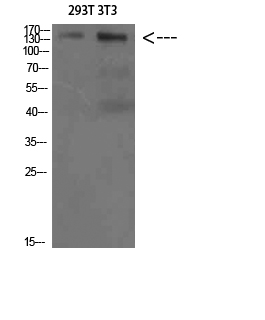AMBRA1 Polyclonal Antibody
- 产品详情
- 实验流程
- 背景知识
Application
| WB, E |
|---|---|
| Primary Accession | Q9C0C7 |
| Reactivity | Human, Mouse |
| Host | Rabbit |
| Clonality | Polyclonal |
| Calculated MW | 142507 Da |
| Gene ID | 55626 |
|---|---|
| Other Names | autophagy/beclin-1 regulator 1 |
| Dilution | WB~~WB 1:500-2000, ELISA 1:10000-20000 E~~N/A |
| Format | Liquid in PBS containing 50% glycerol, 0.5% BSA and 0.09% (W/V) sodium azide. |
| Storage Conditions | -20℃ |
| Name | AMBRA1 {ECO:0000303|PubMed:17589504, ECO:0000312|HGNC:HGNC:25990} |
|---|---|
| Function | Substrate-recognition component of a DCX (DDB1-CUL4-X-box) E3 ubiquitin-protein ligase complex involved in cell cycle control and autophagy (PubMed:20921139, PubMed:23524951, PubMed:24587252, PubMed:32333458, PubMed:33854232, PubMed:33854235, PubMed:33854239). The DCX(AMBRA1) complex specifically mediates the polyubiquitination of target proteins such as BECN1, CCND1, CCND2, CCND3, ELOC and ULK1 (PubMed:23524951, PubMed:33854232, PubMed:33854235, PubMed:33854239). Acts as an upstream master regulator of the transition from G1 to S cell phase: AMBRA1 specifically recognizes and binds phosphorylated cyclin-D (CCND1, CCND2 and CCND3), leading to cyclin-D ubiquitination by the DCX(AMBRA1) complex and subsequent degradation (PubMed:33854232, PubMed:33854235, PubMed:33854239). By controlling the transition from G1 to S phase and cyclin-D degradation, AMBRA1 acts as a tumor suppressor that promotes genomic integrity during DNA replication and counteracts developmental abnormalities and tumor growth (PubMed:33854232, PubMed:33854235, PubMed:33854239). AMBRA1 also regulates the cell cycle by promoting MYC dephosphorylation and degradation independently of the DCX(AMBRA1) complex: acts via interaction with the catalytic subunit of protein phosphatase 2A (PPP2CA), which enhances interaction between PPP2CA and MYC, leading to MYC dephosphorylation and degradation (PubMed:25438055, PubMed:25803737). Acts as a regulator of Cul5-RING (CRL5) E3 ubiquitin- protein ligase complexes by mediating ubiquitination and degradation of Elongin-C (ELOC) component of CRL5 complexes (PubMed:25499913, PubMed:30166453). Acts as a key regulator of autophagy by modulating the BECN1-PIK3C3 complex: controls protein turnover during neuronal development, and regulates normal cell survival and proliferation (PubMed:21358617). In normal conditions, AMBRA1 is tethered to the cytoskeleton via interaction with dyneins DYNLL1 and DYNLL2 (PubMed:20921139). Upon autophagy induction, AMBRA1 is released from the cytoskeletal docking site to induce autophagosome nucleation by mediating ubiquitination of proteins involved in autophagy (PubMed:20921139). The DCX(AMBRA1) complex mediates 'Lys-63'-linked ubiquitination of BECN1, increasing the association between BECN1 and PIK3C3 to promote PIK3C3 activity (By similarity). In collaboration with TRAF6, AMBRA1 mediates 'Lys-63'-linked ubiquitination of ULK1 following autophagy induction, promoting ULK1 stability and kinase activity (PubMed:23524951). Also activates ULK1 via interaction with TRIM32: TRIM32 stimulates ULK1 through unanchored 'Lys-63'-linked polyubiquitin chains (PubMed:31123703). Also acts as an activator of mitophagy via interaction with PRKN and LC3 proteins (MAP1LC3A, MAP1LC3B or MAP1LC3C); possibly by bringing damaged mitochondria onto autophagosomes (PubMed:21753002, PubMed:25215947). Also activates mitophagy by acting as a cofactor for HUWE1; acts by promoting HUWE1- mediated ubiquitination of MFN2 (PubMed:30217973). AMBRA1 is also involved in regulatory T-cells (Treg) differentiation by promoting FOXO3 dephosphorylation independently of the DCX(AMBRA1) complex: acts via interaction with PPP2CA, which enhances interaction between PPP2CA and FOXO3, leading to FOXO3 dephosphorylation and stabilization (PubMed:30513302). May act as a regulator of intracellular trafficking, regulating the localization of active PTK2/FAK and SRC (By similarity). Also involved in transcription regulation by acting as a scaffold for protein complexes at chromatin (By similarity). |
| Cellular Location | Endoplasmic reticulum. Cytoplasm, cytoskeleton. Cytoplasmic vesicle, autophagosome {ECO:0000250|UniProtKB:A2AH22}. Mitochondrion. Cytoplasm, cytosol {ECO:0000250|UniProtKB:A2AH22}. Nucleus. Cell junction, focal adhesion {ECO:0000250|UniProtKB:A2AH22}. Note=Localizes to the cytoskeleton in absence of autophagy induction (PubMed:20921139). Upon autophagy induction, AMBRA1 relocalizes to the endoplasmic reticulum to enable autophagosome nucleation (PubMed:20921139). Partially localizes at mitochondria in normal conditions (PubMed:21358617). Also localizes to discrete punctae along the ciliary axoneme (By similarity) {ECO:0000250|UniProtKB:A2AH22, ECO:0000269|PubMed:20921139, ECO:0000269|PubMed:21358617} |
Research Areas
For Research Use Only. Not For Use In Diagnostic Procedures.
Application Protocols
Provided below are standard protocols that you may find useful for product applications.
BACKGROUND
Regulates autophagy and development of the nervous system. Involved in autophagy in controlling protein turnover during neuronal development, and in regulating normal cell survival and proliferation (By similarity).
终于等到您。ABCEPTA(百远生物)抗体产品。
点击下方“我要评价 ”按钮提交您的反馈信息,您的反馈和评价是我们最宝贵的财富之一,
我们将在1-3个工作日内处理您的反馈信息。
如有疑问,联系:0512-88856768 tech-china@abcepta.com.
¥ 1,500.00
Cat# AP73945























 癌症的基本特征包括细胞增殖、血管生成、迁移、凋亡逃避机制和细胞永生等。找到癌症发生过程中这些通路的关键标记物和对应的抗体用于检测至关重要。
癌症的基本特征包括细胞增殖、血管生成、迁移、凋亡逃避机制和细胞永生等。找到癌症发生过程中这些通路的关键标记物和对应的抗体用于检测至关重要。 为您推荐一个泛素化位点预测神器——泛素化分析工具,可以为您的蛋白的泛素化位点作出预测和评分。
为您推荐一个泛素化位点预测神器——泛素化分析工具,可以为您的蛋白的泛素化位点作出预测和评分。 细胞自噬受体图形绘图工具为你的蛋白的细胞受体结合位点作出预测和评分,识别结合到自噬通路中的蛋白是非常重要的,便于让我们理解自噬在正常生理、病理过程中的作用,如发育、细胞分化、神经退化性疾病、压力条件下、感染和癌症。
细胞自噬受体图形绘图工具为你的蛋白的细胞受体结合位点作出预测和评分,识别结合到自噬通路中的蛋白是非常重要的,便于让我们理解自噬在正常生理、病理过程中的作用,如发育、细胞分化、神经退化性疾病、压力条件下、感染和癌症。






